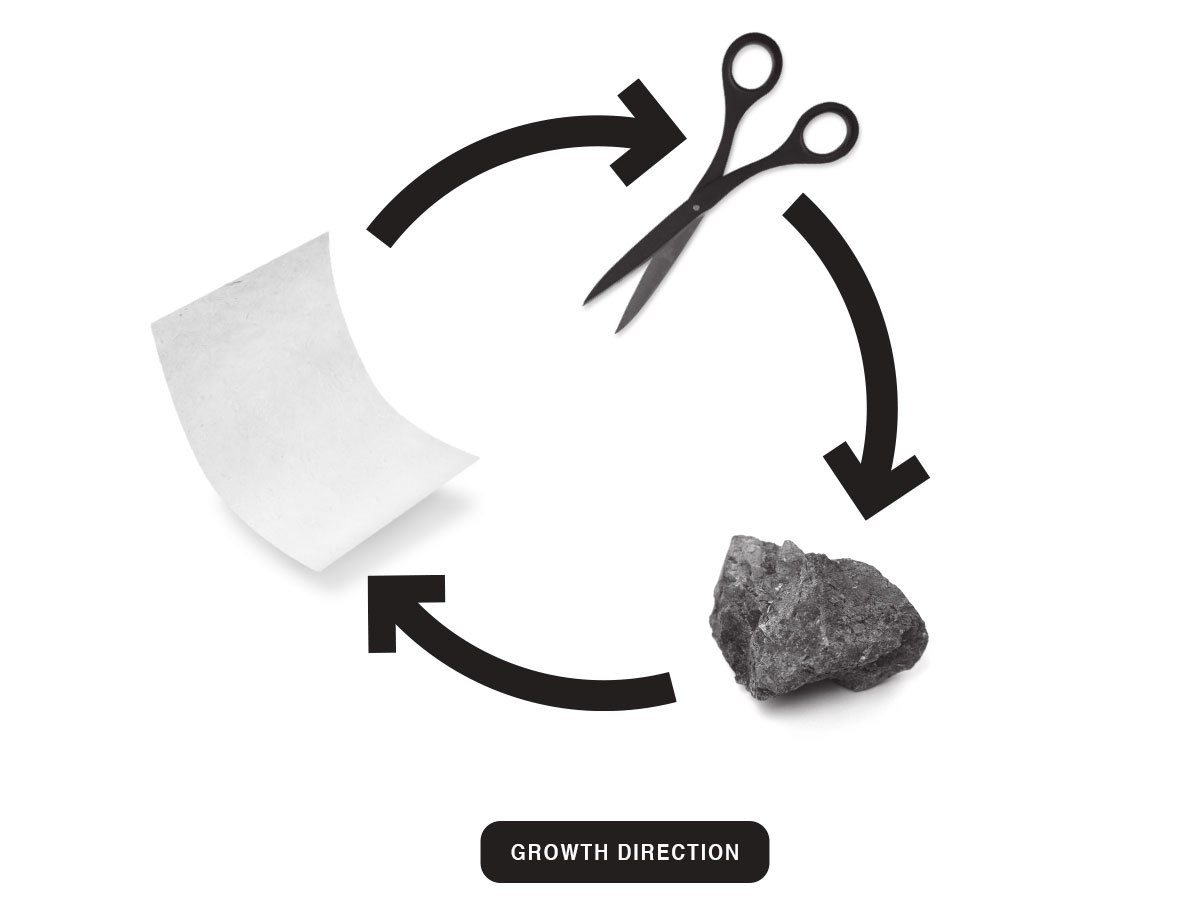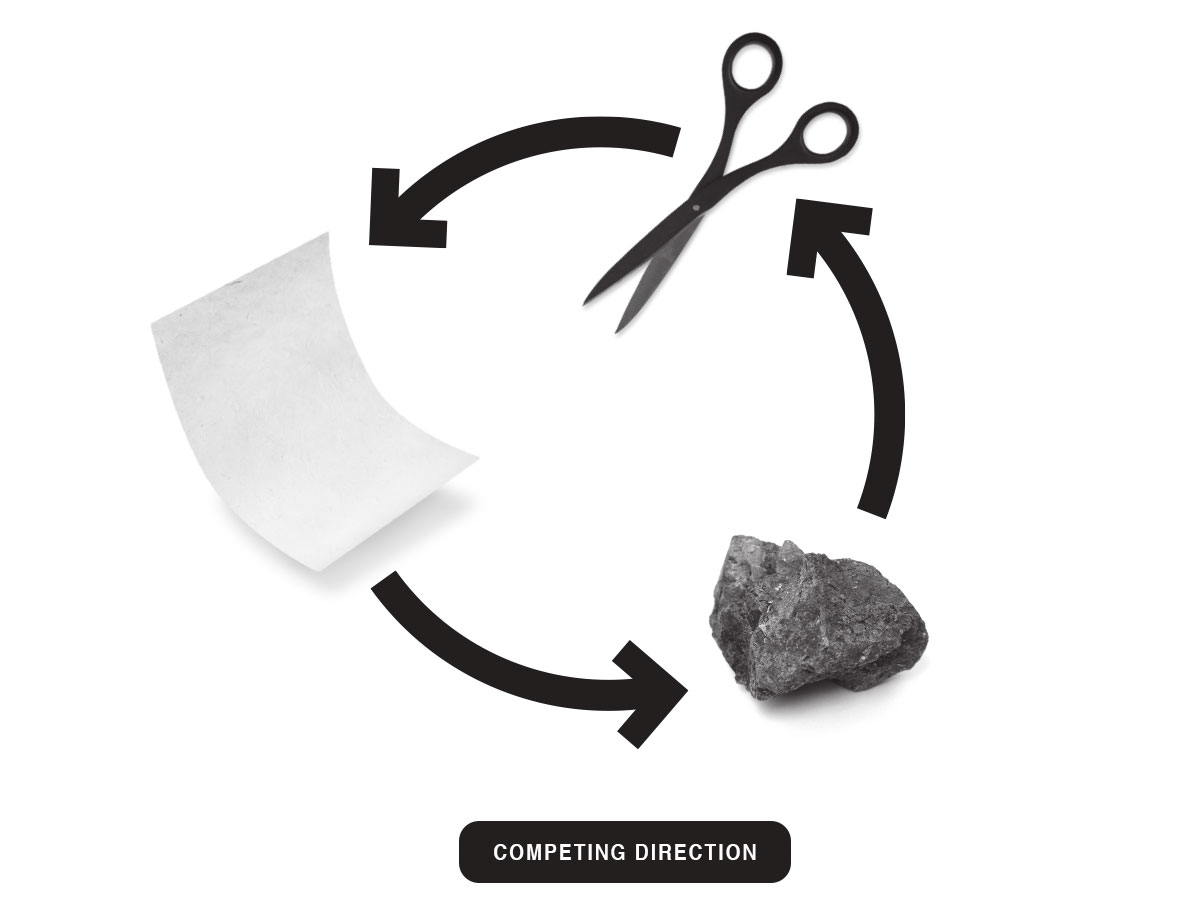HOW TO COMPETE AGAINST ANY SIZE COMPANY AND WIN
Whenever I give a workshop on strategic focus, I can count on getting this question: If focus is so important to success, how can so many unfocused companies grow so large? In other words, how can you explain the success of a company like General Electric, which markets everything from power plants to plastics, and light bulbs to light rail systems? Or Mitsubishi, which puts its name on 23,720 offerings from automobiles to aerospace, textiles to tobacco, and banks to broccoli?
The fact is, as powerful as the principle of focus is, companies with different approaches to focus can coexist in the marketplace. Perhaps the easiest way to understand how this can happen is through the children’s game of Scissors Paper Rock. Remember how it goes? Scissors cuts paper, paper covers rock, rock breaks scissors. Each position has its strengths and each has its weaknesses, creating a balanced cycle of competition.
Business history has shown that companies thrive best when they settle into “stable states,” conditions in which the business environment is fairly predictable and employees have confidence in what they’re doing. In self-organization theory—the part of chaos theory that studies how order seems to arise spontaneously in complex systems—these stable states are called “attractors.” As a company grows, it’s attracted toward one of three main states, which we can call scissors, paper, and rock.
A “scissors” company is a startup or small business, often having only one brand. What distinguishes a scissors company is its extremely sharp focus. It competes by snipping small pieces of business from the market dominated by much larger “paper” companies, who are either too busy to notice or too slow to respond.
As a scissors company becomes successful and begins to grow, it morphs into a “rock” company, a medium-sized organization that typically has more brands and less focus. Its defining characteristic is no longer focus but momentum. Rock companies thrive by crushing “scissors” companies, who don’t have the resources to compete head to head with them.
As a rock company grows, its momentum begins to fade, and eventually it turns into a “paper” company. What distinguishes a paper company is its sheer size. With even more brands and even less focus, it survives by using its network and resources to smother “rock” companies.
And round and round they go.
There are three observations you can make about the competition cycle: 1) companies tend to grow clockwise, from scissors to rock to paper; 2) they tend to compete counter-clockwise—paper covers rock, rock breaks scissors, scissors cuts paper; and 3) the spaces between the stable states are “unstable states”—periods of time when change is not only possible but necessary. It’s during these unstable periods that companies often need to reposition their brands.
Now let’s look more closely at the ways each type of competitor can maximize its particular advantage.
THE FOCUS OF SCISSORS
In the book THE INNOVATOR’S SOLUTION, Clayton Christensen and Michael Raynor divide innovation into two types—“sustaining” innovation, which calls for incremental improvements to existing offerings, and “disruptive” innovation, which attempts to find new market space, often with products or services that are less expensive and initially perceived as “not as good.” It’s their focus on a disruptive innovation that allows scissors companies to outmaneuver paper companies.
So why don’t paper companies counterattack with disruptive offerings of their own? Because of “asymmetric motivation.” When a company moves upmarket, much of the incremental revenue falls to the bottom line. When a company moves down-market, little of the incremental revenue falls to the bottom line. Large companies can’t make enough profit on emerging markets, so they take a pass.
An example of disruptive innovation is eBay, a company that became “the world’s online marketplace” before the world thought it needed one. EBay thrived in the scissors state for the better part of a decade. Said then-CEO Meg Whitman, “Young companies are very well served by focusing.”
THE MOMENTUM OF ROCK
As growth opportunities become clear, scissors companies move through the first unstable state on their road to rock. They may think about adding brands or subbrands, or acquiring other companies. Process begins to replace passion as they codify what worked in the early years. They may consider going public during this period, or bringing in professional managers.
When they do reach rock, they suddenly become dangerous to paper companies, who had paid little attention to them. The paper companies are now motivated to smother the rock companies by matching any new offerings—offerings that may be less disruptive and more like what the paper companies can profit from.
If scissors companies go public during the transition, their momentum may increase with the sudden infusion of cash, but it will soon be tempered by rising levels of risk aversion, as shareholders pressure management for ever-increasing earnings.
Yet rock companies have a tremendous natural advantage: the “big mo” allows them to enter new markets, attract world-class talent, and buy up the scissors companies they used to compete with.
THE SIZE OF PAPER
Eventually, the momentum of a rock company slows, and it passes through a second unstable state on its way to becoming paper. The biggest challenge the company faces during this transition is keeping the growth engine running. By now it has probably made some serious mistakes and may have lost a great deal of its original fire and focus. If the founder is still in charge, this will be the most likely time for a change of leadership.
The first thing the new leader must do is refocus the business and win back the confidence of shareholders. He or she will reduce head count, prune back unprofitable lines of business, and remodel the brand architecture. While the company will never regain the sharp focus of a scissors company, whatever it lacks in focus it makes up for in size. With size comes a broad network of customers, partners, distributors, and employees, plus access to large reservoirs of capital.
Just as scissors companies achieve the quickest success with disruptive innovation, paper companies achieve it with “sustaining innovation.” They win by making incrementally better products that can be sold for higher prices to attractive customers. Meanwhile, with rock companies breathing down their necks and scissors companies attacking them through the niches, paper companies are under constant pressure to grow even larger in self defense.
There’s strong evidence, however, to suggest that every company has its maximum size, beyond which it cannot grow profitably. At that point it tends to renew itself by completing the cycle of competition—by fueling the next scissors generation. It refocuses, spinning off lines of business into smaller companies. It downsizes, scattering talented managers like seeds into niche businesses. And it discontinues investments in innovations that aren’t likely to pay off big enough or soon enough. All of which refreshes the bottom line, and all of which feeds the success of scissors companies.
The paper-scissors-rock model, by virtue of its simplicity, clearly reveals the life cycle of a business. It also shows that the most challenging stage is the last, as large companies like General Electric and Mitsubishi push up against the natural limits of their growth.


